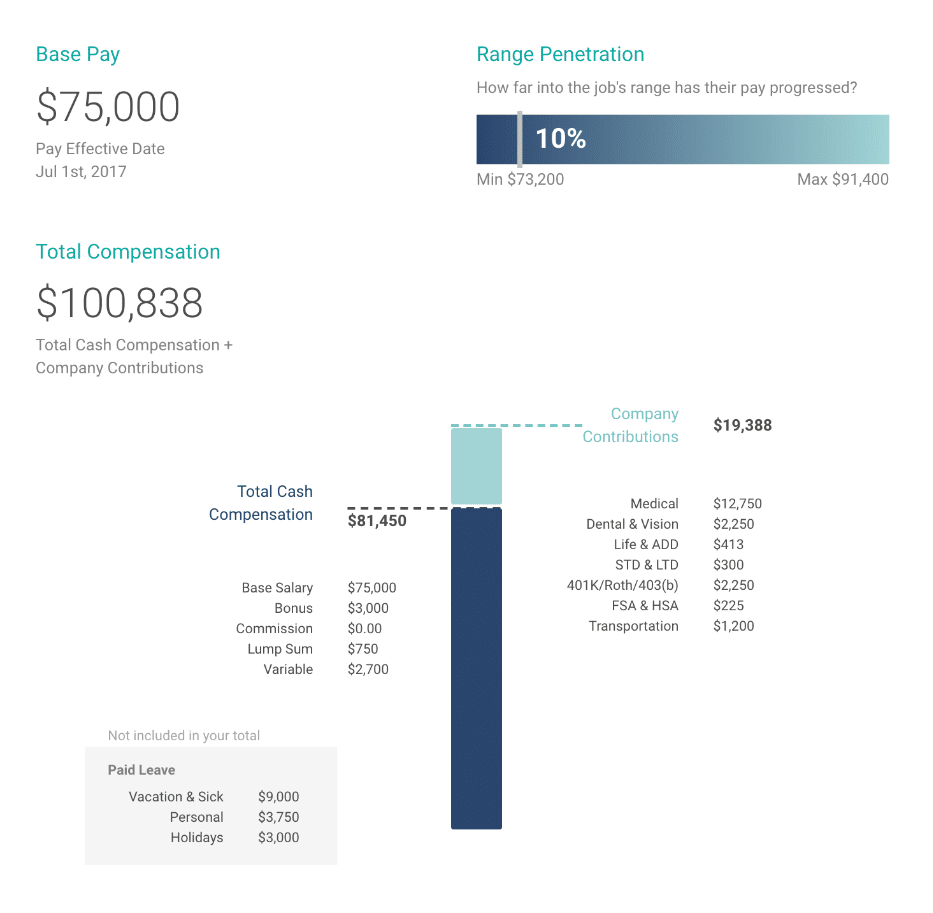When times are tough, transparent communication is essential to keep morale high, especially around compensation. If you need employees to buckle down, do more with less, accept lower wages, relinquish valuable benefits, or brace for layoffs, you’ll do better overall if they know why and how they are valued. If you don’t communicate compensation, especially in an uncertain economy, employees are likely to talk among themselves and come to the wrong conclusions.
According to our 2020 Compensation Best Practices Report, 70 percent of organizations either have a compensation strategy or are working on one, but only 32 percent train managers to talk about compensation with employees. If you are like the majority of organizations, your managers are either not having these conversations or are winging it. Recognizing that this is both an oversight and an opportunity, you might wonder how to tactically go about conducting manager training on pay communications, especially given the economic uncertainty resulting from the coronavirus crisis.
That’s what we intend to cover in this post. We will provide you with an agenda and detailed recommendations for training managers on how to talk to employees about pay.
In times of economic uncertainty especially, your employees will look to HR and executive leadership for reassurance and to try and gauge whether the ship is sinking or sailing smoothly. How you handle these conversations can go a long way toward reassuring your workers and decreasing the risk of losing talent with the skills you need to keep your organization moving forward.
Don’t assume managers know how to talk about compensation
Before you do anything, you first need to eliminate the assumption that managers already know how to have conversations with employees about pay. Even seasoned leaders can struggle with explaining compensation. It’s traditionally seen as a sensitive topic and managers don’t come educated in the nuances of compensation. They may not know how to talk about pay ranges or market data or how compensation decisions are made within your organization. They may also assume that you don’t want them to conduct pay conversations with employees without specific instruction from HR — and you probably don’t.
Unless you have specifically trained managers on your compensation philosophy and set expectations around pay communications, it is best to assume they aren’t doing it or are doing it all differently. For example, some managers might be having open and candid conversations with employees about pay while other managers are not. This creates an inconsistent experience for employees and opens the organization up to risk. Therefore, it is really important to establish a policy and provide training around how compensation is determined and what managers should say about it to employees.
It’s also not in the best interest of your organization to instruct managers – actively or tacitly – to wait for employees to bring up compensation. By this time, employees are likely already frustrated. A more proactive approach to pay communications will build trust in the organization and reduce unproductive turnover through the boosting of morale, which is especially critical when times are tough.
With effective training in pay communications, all managers within your organization will be able to have proactive conversations with their employees about how the organization values them. They will know what to cover in these discussions, what they are allowed to say about how compensation decisions are made and what questions they should pass along to HR.
Of course, different organizations are going to be comfortable with different levels of pay transparency. Only you know where your organization falls within the pay transparency spectrum. Be sure to adjust our recommendations to fit your specific organization’s mission and culture.
Setting the Meeting Agenda on Pay Communications Training
When you are ready to train managers to talk about compensation, here is a sample agenda you can use:
- Welcome and Statement of Training Purpose
- Present the Compensation Toolkit
- How to Use a Total Compensation Statement (TCS)
- How to Talk about Career Pathing
- How to Handle Difficult Questions
- How to Close the Compensation Meeting
- Questions and Answers and Next Steps
We’ll take a look at each step in more detail.
Welcome and Statement of Purpose
Any well-organized meeting will open with a welcome and a statement about what the meeting is meant to accomplish. This is a critical part of meeting etiquette as it assures busy managers that this meeting is worth their time and attention.
The statement of purpose should include why this is an important exercise. Depending on your level of transparency with managers, you might want to share data on employee turnover and associated hiring costs, or anecdotal evidence of how a lack of pay communications has negatively impacted your organization, such as online reviews or commentary from surveys or exit interviews. For a more positive spin, you can emphasize the culture of your organization and how strategic pay communications can raise the credibility of your employer brand and boost morale.
This is also the time to share the agenda of the meeting and tell attendees whether and when to ask questions.
How to Create a Compensation Conversation Toolkit
To be as effective as possible, you should be prepared to walk managers through a conversation with employees, including what they will need to have on hand to make the conversation as productive as possible. You might also put together a checklist as well as an example toolkit of the materials that managers will need to gather before sitting down with an employee to discuss compensation.
Here are some essential elements of a compensation conversation toolkit:
Salary History and Performance: Before sitting down with an employee to talk about their compensation, managers should review the employee’s history with the organization. They should be able to see how long the employee has been with the company, when they have gotten raises or promotions, for what reason, and how much. This shows the employee that their manager is aware and appreciative of the employee’s time with them and gives the manager a more holistic understanding of the employee’s contribution to date. Reference to past performance reviews and goals may also be useful for managing pay communications with employees. Going through the story of the employee’s time with the company can be clarifying for both parties.
Compensation Philosophy: Your compensation philosophy is a summary of how your organization makes decisions about pay based on how your organization competes in the market for talent. For example, does the organization pay at, above or below market rate? For which jobs? Why? Managers should be able to articulate this philosophy at a high level to employees if doing so aligns to your level of pay transparency. Providing a rationale for pay decisions goes a long way in boosting confidence in managerial decisions.
Compensation FAQ: Compensation professionals and HR managers know what questions employees ask most frequently when it comes to pay and can arm managers with answers by creating an FAQ.
Examples of frequently asked questions might include:
-
- How is my pay determined?
- How often can I expect a raise? What is the typical amount given?
- What if my job responsibilities have changed or my performance is particularly exceptional? Are merit increases provided for this position? How are those determined?
- Are salaries adjusted for cost-of-living? How often is this reviewed?
- Can I earn more with a certification or by acquiring new skills?
- Am I eligible for bonuses, profit-sharing, or other variable pay? How is that determined?
- What is the value of total rewards? (break down of compensation and benefits)
- What is the process for earning and receiving a promotion? How can I grow within the organization?
- Can I still expect a merit-based raise or variable pay in the current crisis?
When creating an FAQ, it’s important to remember that employees and managers don’t have as much knowledge or experience as you when it comes to these discussions. Steer clear of jargon and don’t assume that your managers understand where market data for pay ranges comes from. You might need to walk them through the data you use to determine pay, why it can be trusted, and what information can and should be shared with employees to give them confidence in your approach.
Total Compensation Statement: Managers should be trained on total compensation and prepared to discuss the value of benefits versus variable pay and base pay with employees. Depending on the maturity of your compensation structure and level of pay transparency, they may also need to know where the employee falls within the pay range for their position and why. It is particularly important that benefits and perks are explained, as these vary tremendously across organizations, especially if the employee may be a flight risk.
How to Open the Conversation about Compensation
The manager should set the tone of a meeting about compensation within the first few minutes. Body language should be open and relaxed. However, managers should treat the conversation seriously, not flippantly, and speak in a manner that is respectful and considerate of how much compensation means to the employee’s sense of self-worth.
The manager should clearly state why the meeting is happening and what will be covered. They should encourage their employee to ask questions. Before digging into the details, they should make sure the employee understands that a compensation review is not an evaluation of performance – at least, the employee’s performance should not come as a surprise – and that the employee is valuable to the organization.
In general, managers should be trained to behave as coaches rather than bosses. The focus of the conversation should be on the employee’s contribution to the team and prospects for growth. If the employee is eligible for a raise, what will be expected from them? If not, what can the employee do to get to the next level? If the organization is entering into pay communications as part of a response to a financial crisis and has decided to issue pay cuts, what are the reasons, who is affected, how long will it last, and what are the employee’s options?
How to Use a Total Compensation Statement
As mentioned above, managers will be best equipped if they can come to pay conversations with information on the employee’s total compensation package. This includes variable pay and benefits as well as base pay. Ideally, a Total Compensation Statement (TCS) is printed out like the Employee Report auto-generated from PayScale Insight Lab.

Be sure your managers understand how to put together and use the TCS, whether pulled from a system or created separately. A great way to train managers on this is by going over their own TCS with them or run through a mock example in front of a group. Model the conversation they will have with employees. See what questions naturally come up.
This extra step could have the added benefit of reassuring managers who are also concerned about the financial future of the organization. After all, managers are employees too and just as likely to feel nervous about any uncertainty they detect from leadership regarding their value. Reassure them so they can in turn confidently reassure their employees.
How to Talk About Career Pathing
Questions about compensation are often inspired by uncertainty in growth opportunities. Before managers can talk about career paths with their employees, the organization needs career paths that are defined. Here are three questions to ask:
- Are there real career opportunities available within your organization?
- Are these visible to your talent pool?
- Are there support structures that facilitate internal career moves?
If the answer to each of these questions is yes, your organization is in a solid place when it comes to established career paths. You can be sure managers know how to answer these questions and are equipped to talk specific career path options with each of their employees.
If, however, you can’t answer yes to these questions, there’s more work that needs to happen on the HR side of the equation. This might be especially true for non-traditional career paths.
Managers also need to be able to talk to employees about their general goals and ambitions. An employee who looks ahead and doesn’t see a way to grow is more likely to leave your organization. To prevent unproductive turnover, managers should alert HR if anything is amiss with an employee’s understanding of their growth potential and if a career path needs to be defined.
How to Handle Difficult Questions about Compensation
No matter how well-trained and prepared managers are for compensation conversations, employees are bound to ask questions they cannot answer. Teach your managers how to handle those questions. Be specific about what questions they absolutely should not attempt to answer. Be specific about what questions they are legally required to pass along to HR. Give them the specific language they should use.
For example: “That’s an important question and I’m glad you brought it up. I need to follow up with HR to be sure I’m answering it with the most accurate information, so I will circle back to you by [specific date] with the answer.”
Have managers practice and role-play with you to be sure they can remain cool and confident in the face of challenging questions. More than anything, they need to inspire confidence in the organization to build and foster trust, even when they can’t offer a specific answer at that time.
How to Close the Conversation
When it comes to ending pay conversations, managers should do the following:
- Ask the employee if there are any other questions and answer them appropriately.
- Make note of follow-up tasks as needed, with estimated deadlines shared with the employee.
- Note the employee’s morale at the end of the meeting. Is the employee feeling satisfied and confident or stony and disgruntled? The manager should flag any potential morale issues and escalate to HR to help stop discontent from spreading to the rest of the team.
Make it clear to your managers that they are the most important line of defense when it comes to preventing turnover. Emphasize your role in these conversations and debrief when necessary.
Questions and Answers
Once you’ve completed the training, open the floor to managers to ask questions. You can role-play different scenarios your managers have encountered or provide examples of scenarios you’ve experienced.
Conclusion
Compensation conversations can be scary, but it’s more frightening for employees not to know what is going on. With the right training, your managers can approach pay communications confidently to help improve morale across the organization, which can go a long way to reducing turnover during uncertain times. Now is the time to be a team and work together to remind your employees (managers and all) that they are valued by the business.
For more information, including example scenarios and how to respond, check out our whitepaper, “The Definitive Guide to Effective Pay Communications.”



